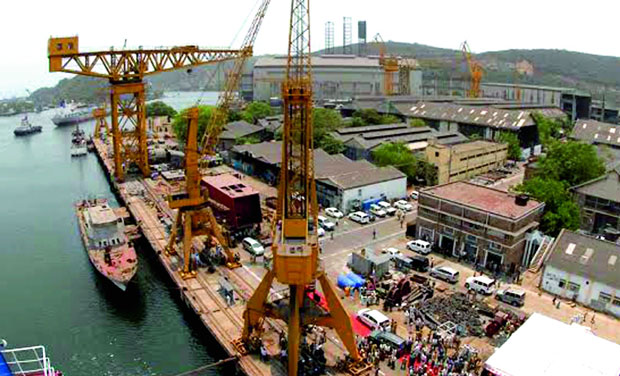
The ABC of ABG Shipyard’s ₹22,842-crore bank fraud
The rapid rise and quick descent of the Gujarat-based shipbuilding giant, and the snail-paced probe into the scam it perpetrated

From Vijay Mallya and Nirav Modi to Yes Bank and DHFL, India has seen some big-ticket financial frauds. The mother of them all is just unravelling, with ABG Shipyard Ltd (ABGSL) under the scanner for allegedly defrauding 28 banks to the tune of around ₹22,842 crore.
The Central Bureau of Investigation is burrowing into the books, and has issued look-out orders against the company’s promoters and directors as well as government employees suspected of aiding the fraud. The political blame-game, meanwhile, is already on at full swing.
Who owns ABG Shipyard, and what does it do?
ABGSL is a Surat-based, publicly listed shipbuilding and ship repairing company established in 1985. It’s run by Rishi Agarwal-promoted ABG Group of Companies, which has diversified operations. The company has shipyards in Surat and Dahej in Gujarat and, in its hey days, its product range included commercial vessels, split barges, floating cranes and container ships, to name just some. At its peak, it had an order book of ₹16,600 crore.
Also read: Himalayan blunder: All you need to know about a yogi running the NSE
The company expanded rapidly and made several acquisitions on the way. In 2010, it acquired Western India Shipyard Ltd, which runs a huge ship repair unit in Goa. ABGSL even held government clearance to build products for the Navy, such as warships.
With a net profit of ₹107 crore, it was a thriving business until the end of 2012-13. The next year, however, it posted a loss of ₹199 crore. In a couple of years, the loss widened to ₹3,704 crore (March 2016). The reasons cited were the cancellation of new shipbuilding orders, high borrowing costs, low capacity utilisation at Dahej, reduced lending from banks, and the expiry of a shipbuilding subsidy scheme. The global economic slowdown of 2008 is also suspected to have hit ABGSL, as orders dried up.
When did things go south for the company?
Since 2001, ABGSL had been doing business with State Bank of India (SBI), raising debt for its acquisitions, capital expenditure and so on. Subsequently, it raised loans from several other banks, too. The account turned into a ₹22,842 crore non-performing asset (NPA) in November 2013. The loan disbursements happened between 2005 and 2012 via 28 banks, including ICICI, IDBI Bank, Bank of Baroda, and Indian Overseas Bank, apart from SBI.
In March 2014, the shipping giant’s debt was restructured, but its operations could not be revived. In September that year, NV Dand & Associates, an accounting firm, was roped in to run an audit of the company. In April 2016, NV Dand submitted its audit report, pointing to various instances of financial misconduct by ABGSL.
In July 2016, the ABGSL account was once again declared an NPA, with retrospective effect from November 30, 2013. In August 2017, unable to recover its dues, ICICI Bank referred ABGSL to the National Company Law Tribunal (NCLT) to request a corporate insolvency resolution process (CIRP). In April 2018, EY was signed up by the lenders for a forensic audit of the firm, to cover the period from 2012 to 2017.
Also read: Indian Inc pays lip service to diversity and inclusion. Real change is hard
As the findings began to emerge, several banks declared the ABGSL account as fraud. In August 2020, SBI moved the CBI on the matter. Following a detailed probe, an FIR was registered on February 2, 2022. On February 12, nearly 15 searches of company premises were made, yielding several incriminating documents.
What is the extent of the fraud?
It is evident that ABGSL took massive loans from various banks and diverted the proceeds for purposes that were not disclosed. This included fund transfers to overseas subsidiaries, acquisition of assets and transfers to related parties. The CBI’s probe report said ABGSL floated nearly 100 companies to syphon off funds that were used to create personal assets of the company executives.
The fraud predominantly took place between 2007 and 20012. The CBI said the ABGSL account turned NPA on November 30, 2013.
The accused named in the CBI’s FIR include promoter Rishi Kumar Agarwal as well as other officials such as Santhanam Muthaswamy, Ashwani Kumar, Sushil Agarwal and Ravi Vimal Nevetia.
According to documents available on the public domain, ICICI have been defrauded of ₹7,089 crore, IDBI Bank of ₹3,639 crore, SBI of ₹2,925 crore, Bank of Baroda of ₹1,614 crore, Exim Bank of ₹1,327 crore, Punjab National Bank of ₹1,244 crore, Indian Overseas Bank of ₹1,244 crore and Bank of India of ₹719 crore.
Why did the scam take so long to emerge?
The ABGSL account was declared an NPA in 2016, but it was only in 2019 that SBI termed it a fraud, once EY submitted its forensic report.
SBI filed a complaint with the CBI over 10 months after the EY report, but the Central agency returned it, asking the bank to conduct an internal probe. The next year, SBI filed a fresh complaint with the CBI, saying its own staff was not involved in the scam in any way. After a good 18 months of scrutiny, the CBI took up the case, filing an FIR earlier this month.
While the BJP government at the Centre pointed out that the fraud happened during UPA rule, the Congress hit back, asking to know why the CBI and SBI took nearly seven years to uncover the fraud. The banks, meanwhile, are left in the unenviable position of trying to recover their losses.

